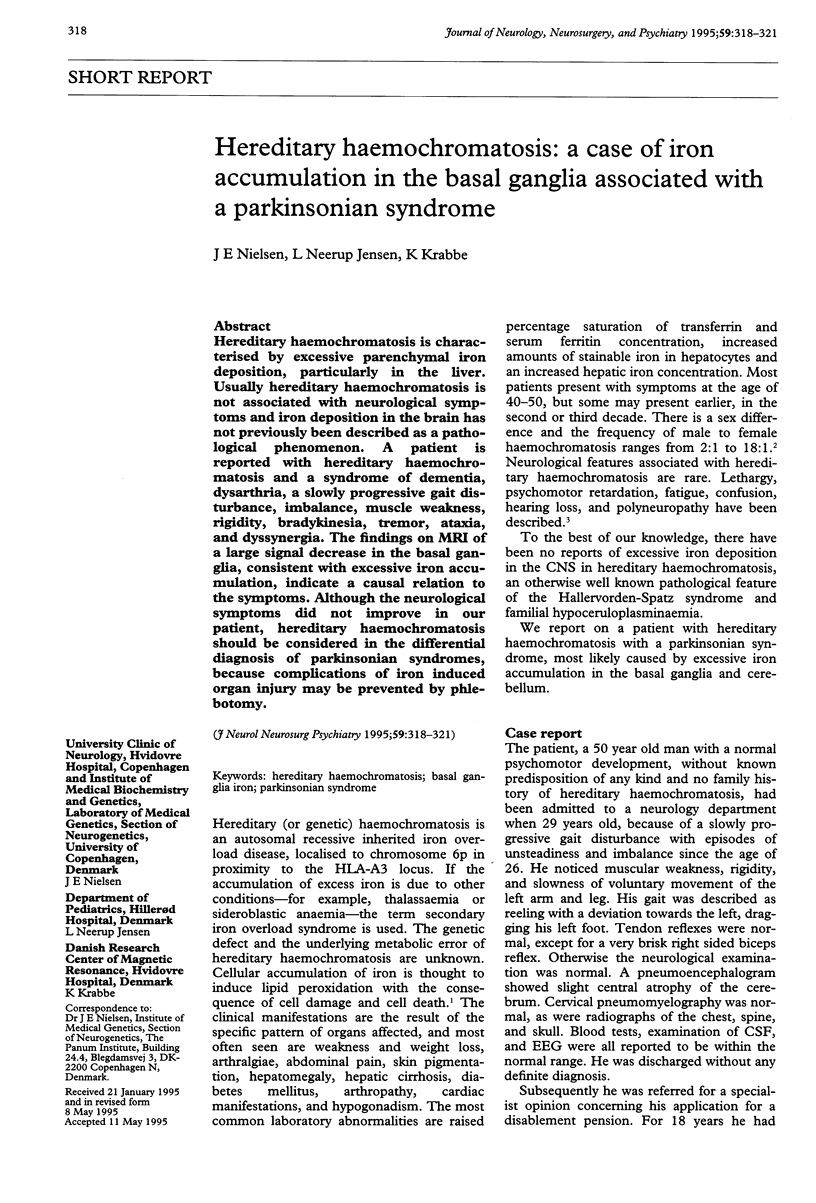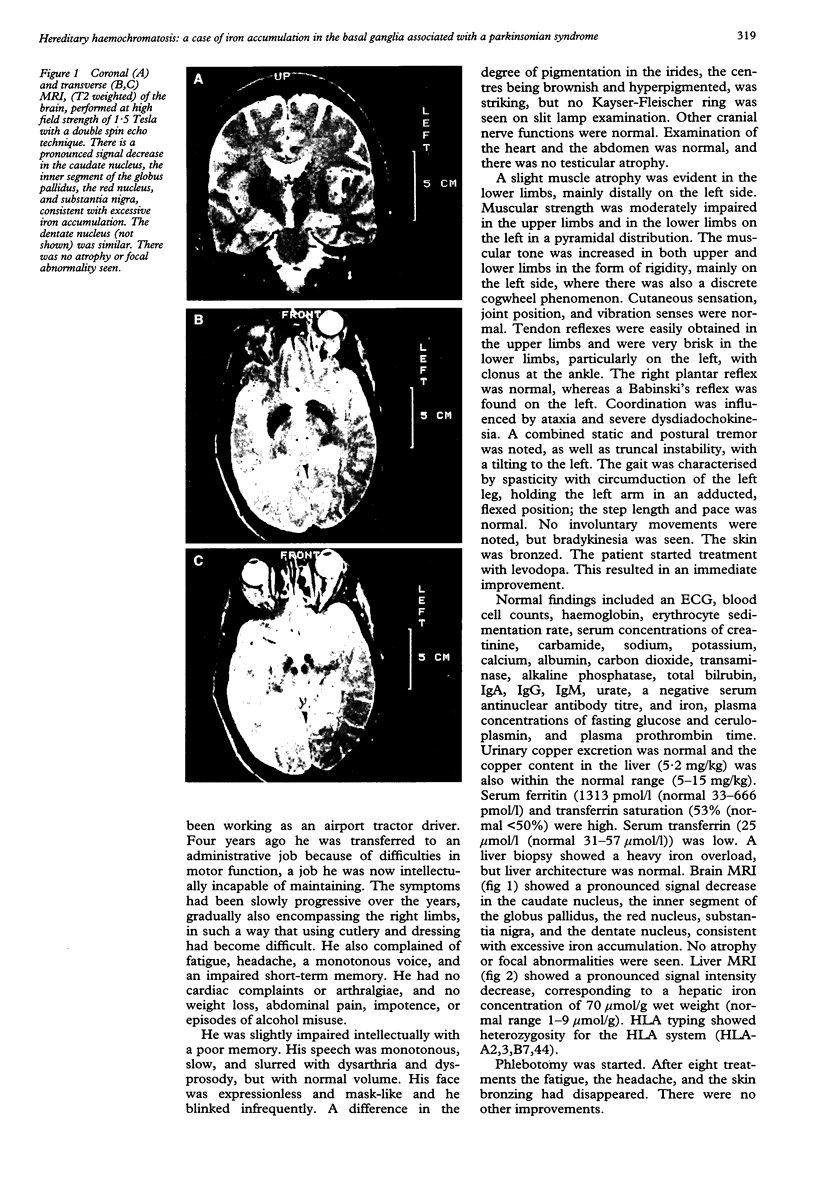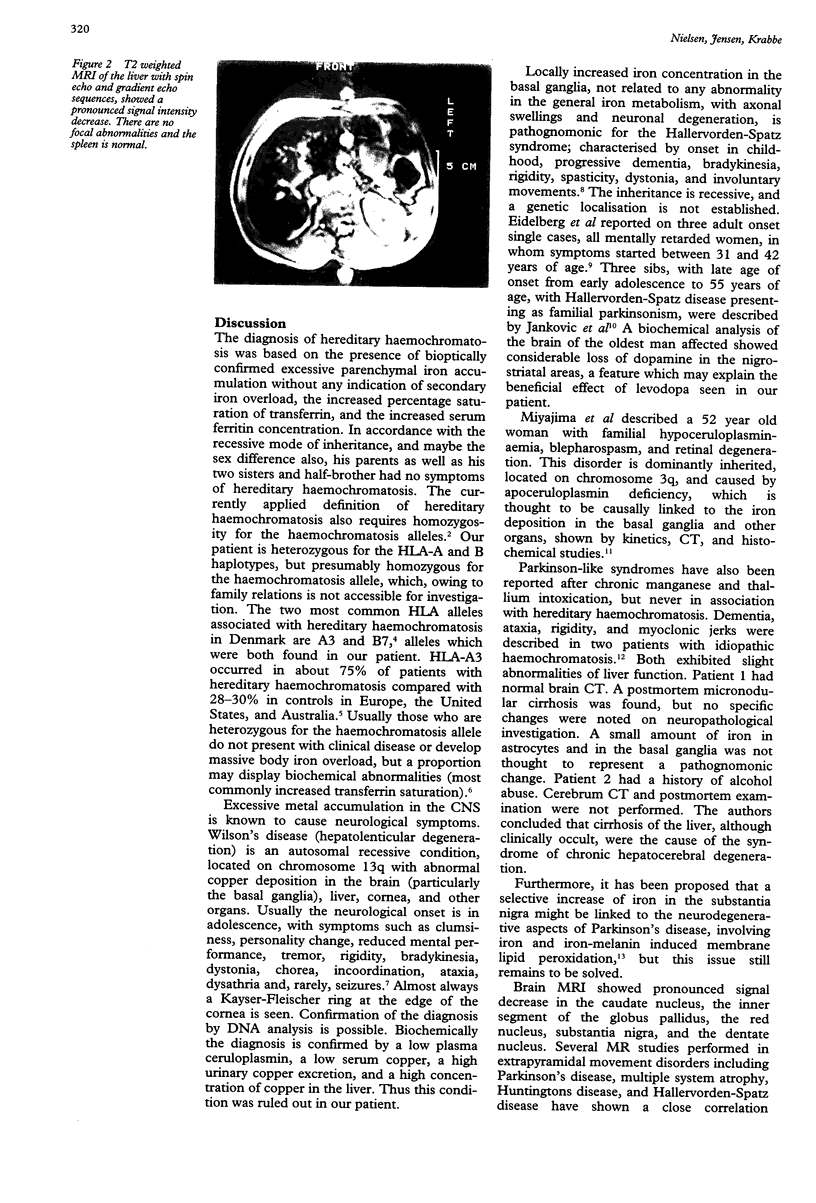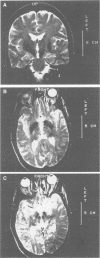Abstract
Hereditary haemochromatosis is characterised by excessive parenchymal iron deposition, particularly in the liver. Usually hereditary haemochromatosis is not associated with neurological symptoms and iron deposition in the brain has not previously been described as a pathological phenomenon. A patient is reported with hereditary haemochromatosis and a syndrome of dementia, dysarthria, a slowly progressive gait disturbance, imbalance, muscle weakness, rigidity, bradykinesia, tremor, ataxia, and dyssynergia. The findings on MRI of a large signal decrease in the basal ganglia, consistent with excessive iron accumulation, indicate a causal relation to the symptoms. Although the neurological symptoms did not improve in our patient, hereditary haemochromatosis should be considered in the differential diagnosis of parkinsonian syndromes, because complications of iron induced organ injury may be prevented by phlebotomy.
Full text
PDF



Images in this article
Selected References
These references are in PubMed. This may not be the complete list of references from this article.
- Chen J. C., Hardy P. A., Kucharczyk W., Clauberg M., Joshi J. G., Vourlas A., Dhar M., Henkelman R. M. MR of human postmortem brain tissue: correlative study between T2 and assays of iron and ferritin in Parkinson and Huntington disease. AJNR Am J Neuroradiol. 1993 Mar-Apr;14(2):275–281. [PMC free article] [PubMed] [Google Scholar]
- Drayer B. P. Magnetic resonance imaging and extrapyramidal movement disorders. Eur Neurol. 1989;29 (Suppl 1):9–12. doi: 10.1159/000116447. [DOI] [PubMed] [Google Scholar]
- Edwards C. Q., Dadone M. M., Skolnick M. H., Kushner J. P. Hereditary haemochromatosis. Clin Haematol. 1982 Jun;11(2):411–435. [PubMed] [Google Scholar]
- Eidelberg D., Sotrel A., Joachim C., Selkoe D., Forman A., Pendlebury W. W., Perl D. P. Adult onset Hallervorden-Spatz disease with neurofibrillary pathology. A discrete clinicopathological entity. Brain. 1987 Aug;110(Pt 4):993–1013. doi: 10.1093/brain/110.4.993. [DOI] [PubMed] [Google Scholar]
- Jankovic J., Kirkpatrick J. B., Blomquist K. A., Langlais P. J., Bird E. D. Late-onset Hallervorden-Spatz disease presenting as familial parkinsonism. Neurology. 1985 Feb;35(2):227–234. doi: 10.1212/wnl.35.2.227. [DOI] [PubMed] [Google Scholar]
- Jones H. R., Jr, Hedley-Whyte E. T. Idiopathic hemochromatosis (IHC): dementia and ataxia as presenting signs. Neurology. 1983 Nov;33(11):1479–1483. doi: 10.1212/wnl.33.11.1479. [DOI] [PubMed] [Google Scholar]
- Milder M. S., Cook J. D., Stray S., Finch C. A. Idiopathic hemochromatosis, an interim report. Medicine (Baltimore) 1980 Jan;59(1):34–49. doi: 10.1097/00005792-198001000-00002. [DOI] [PubMed] [Google Scholar]
- Milman N., Graudal N., Nielsen L. S., Fenger K. An HLA study in 74 Danish haemochromatosis patients and in 21 of their families. Clin Genet. 1992 Jan;41(1):6–11. doi: 10.1111/j.1399-0004.1992.tb03619.x. [DOI] [PubMed] [Google Scholar]
- Miyajima H., Nishimura Y., Mizoguchi K., Sakamoto M., Shimizu T., Honda N. Familial apoceruloplasmin deficiency associated with blepharospasm and retinal degeneration. Neurology. 1987 May;37(5):761–767. doi: 10.1212/wnl.37.5.761. [DOI] [PubMed] [Google Scholar]
- Savoiardo M., Halliday W. C., Nardocci N., Strada L., D'Incerti L., Angelini L., Rumi V., Tesoro-Tess J. D. Hallervorden-Spatz disease: MR and pathologic findings. AJNR Am J Neuroradiol. 1993 Jan-Feb;14(1):155–162. [PMC free article] [PubMed] [Google Scholar]
- Simon M., Le Mignon L., Fauchet R., Yaouanq J., David V., Edan G., Bourel M. A study of 609 HLA haplotypes marking for the hemochromatosis gene: (1) mapping of the gene near the HLA-A locus and characters required to define a heterozygous population and (2) hypothesis concerning the underlying cause of hemochromatosis-HLA association. Am J Hum Genet. 1987 Aug;41(2):89–105. [PMC free article] [PubMed] [Google Scholar]
- Stremmel W., Riedel H. D., Niederau C., Strohmeyer G. Pathogenesis of genetic haemochromatosis. Eur J Clin Invest. 1993 Jun;23(6):321–329. doi: 10.1111/j.1365-2362.1993.tb02031.x. [DOI] [PubMed] [Google Scholar]
- Thomsen C., Wiggers P., Ring-Larsen H., Christiansen E., Dalhøj J., Henriksen O., Christoffersen P. Identification of patients with hereditary haemochromatosis by magnetic resonance imaging and spectroscopic relaxation time measurements. Magn Reson Imaging. 1992;10(6):867–879. doi: 10.1016/0730-725x(92)90440-b. [DOI] [PubMed] [Google Scholar]
- Youdim M. B., Ben-Shachar D., Riederer P. Is Parkinson's disease a progressive siderosis of substantia nigra resulting in iron and melanin induced neurodegeneration? Acta Neurol Scand Suppl. 1989;126:47–54. doi: 10.1111/j.1600-0404.1989.tb01782.x. [DOI] [PubMed] [Google Scholar]




